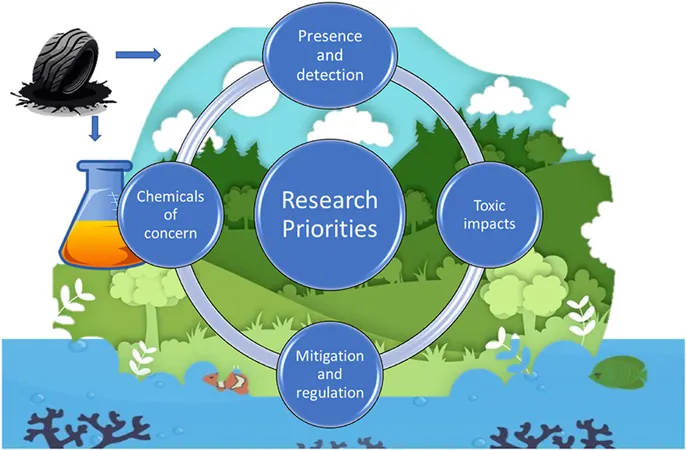
Urgent Warning: Tire Particles Expose Hidden Environmental Danger!
2024-11-13
Author: Jia
Groundbreaking Study Unveils Startling Truth
A groundbreaking study led by an international group of scientists has unveiled a startling truth: tire particles (TPs) are now recognized as a major contributor to the global microplastic crisis, accounting for nearly one-third of all microplastics found in the environment. This new research calls for immediate action and targeted studies to thoroughly investigate the unique environmental and health risks posed by tire particles.
Chemical Complexity of Tire Particles
Unlike conventional microplastics, which are primarily made up of simpler polymer chains, tire particles are created from rubber that contains a complex mixture of synthetic and natural materials. They consist of numerous hazardous additives, including polyaromatic hydrocarbons, heavy metals, and various stabilizing chemicals, making them chemically unique and potentially harmful as they degrade in ecosystems.
Warnings from Researchers
Henry Obanya, a prominent researcher at the Institute of Marine Sciences and the Revolution Plastics Institute at the University of Portsmouth, emphasizes the need for tire particles to be separated from traditional microplastics. "Tire particles are classified as microplastics, yet they leach hundreds of unknown chemicals into our environments, potentially leading to significant health risks," he warns.
Critical Differences in Size and Behavior
The research highlights the critical differences in size and behavior between tire particles and regular microplastics. While typical microplastics are usually smaller than 5mm, tire particles display a wider range of sizes, with some exceeding 5mm. They spread throughout various ecosystems via road runoff and wind, ultimately contaminating waterways, soil, and even entering the food chain.
The Need for More Research
The study, published in the Environmental Research journal, emphasizes a lack of current knowledge regarding TPs' environmental presence, transport mechanisms, and toxic impacts. Experts from the U.K., U.S., Norway, Australia, South Korea, Finland, Austria, China, and Canada contributed to this research, underscoring the need for a standardized framework to quantify and manage the presence of tire particles and their harmful leachates.
Call for Transparency in Tire Production
The researchers have urged for more transparency concerning the chemicals used in tire production. At present, industrial confidentiality limits insights into the specific compounds that make up tire particles, which poses a significant barrier to addressing their risks.
Harmful Effects Observed in Aquatic Life
Alarmingly, recent studies have suggested that chemicals leached from tire particles are present in rivers worldwide, with harmful effects observed in aquatic life. For instance, the tire additive 6PPD and its transformation product, 6PPD-Q, have been linked to devastating mass fish die-offs in North America.
Recommendations for Global Action
The study recommends establishing an intergovernmental science-policy panel dedicated to addressing the issue of tire particles on a global scale. By tackling these pressing research questions rigorously, policymakers could evaluate the risks posed by tire particles more effectively and develop sound regulations to mitigate their effects on ecosystems and human health.
A Path Towards Sustainable Practices
Obanya believes that clearly classifying tire particles and creating targeted regulatory frameworks could pave the way for sustainable practices in the automotive and tire industries, aligning with the United Nations' Sustainable Development Goals.
A Call for Coordinated Efforts
"This study is a clarion call for coordinated international efforts," Obanya asserts. "By recognizing tire particles as a distinct environmental threat, we can initiate meaningful research and policy changes that lead to a healthier, more sustainable world."
Interdisciplinary Research
In a related investigation, Dr. Farhan R. Khan, a senior researcher at the Norwegian Research Center (NORCE), highlighted how the interdisciplinary nature of this research paves the way for comprehensive understanding and future studies on tire particle pollution.
Actionable Steps for Stakeholders
Dr. Imari Walker-Franklin from RTI International echoed the importance of this investigation, stating, "Not only does this research expose critical questions about tire particle pollution, but it also lays down actionable steps for researchers, industry stakeholders, and regulators."
Conclusion: Will Action Be Taken?
As awareness grows, the fight to understand and combat the environmental impact of tire particles is gaining momentum. Will policymakers heed this urgent warning and take action, or will tire particles continue to silently threaten our ecosystems? Stay tuned as this story develops!



 Brasil (PT)
Brasil (PT)
 Canada (EN)
Canada (EN)
 Chile (ES)
Chile (ES)
 España (ES)
España (ES)
 France (FR)
France (FR)
 Hong Kong (EN)
Hong Kong (EN)
 Italia (IT)
Italia (IT)
 日本 (JA)
日本 (JA)
 Magyarország (HU)
Magyarország (HU)
 Norge (NO)
Norge (NO)
 Polska (PL)
Polska (PL)
 Schweiz (DE)
Schweiz (DE)
 Singapore (EN)
Singapore (EN)
 Sverige (SV)
Sverige (SV)
 Suomi (FI)
Suomi (FI)
 Türkiye (TR)
Türkiye (TR)